|
Gray Kingbird Tyrannus dominicensis Pitirre,
|
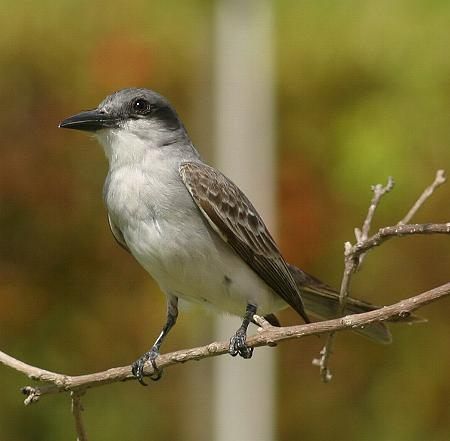 |
|
Photo: A. Sánchez Muñoz
|
|
Gray Kingbird Tyrannus dominicensis Pitirre,
|
 |
|
Photo: A. Sánchez Muñoz
|
|
IDENTIFICATION: Gray above and white below, with a black mask over the eyes. The tail has a slightly forked tip. A few red crown feathers are rarely visible. Length: 22-25 cm.; weight: 42-48 g. VOICE: The common call is one of the most characteristic sounds of Puerto Rico. The call sounds like its Spanish name, "Pitirre," with an accent on the second syllable. The Kingbird repeats its call forcefully from dawn to dusk. It is one of the first birds to start singing at first light, when it has a more prolonged, rolling, dawn song. Audio 4 (M. Oberle). HABITAT: Open country, parks, forest edges, and city streets: anywhere there is a perch and open areas to catch insects in the air. HABITS: Sits on an exposed perch, such as a dead branch, roof top, antenna, or telephone wire, and catches insects in flight or sometimes by gleaning insects off leaves. A sharp, snapping noise can sometimes be heard when the bill closes on an insect. Insect prey include flies, dragonflies, wasps, bees, weevils, other beetles, caterpillars, and occasionally crickets and grasshoppers. Will also eat lizards, and has been reported to capture a small hummingbird. On average, about 1/5 of the diet consists of fruits and berries, which it typically grabs while hovering in front of, or below, the fruit. Young, recently fledged birds may feed entirely on fruit under certain conditions. The kingbird sometimes feeds at night on insects attracted to streetlights. When flying a longer distance, the kingbird flaps its wings rapidly, then glides for an instant: a flight pattern recognizable from a distance. The kingbird is very aggressive---especially during the breeding season---toward neighboring pairs, as well as anything it feels is a potential predator, such as hawks, falcons, egrets, herons, grackles, pelicans, cats, or humans. In fact, a popular expression is "cada guaraguao tiene su pitirre," which means, "every hawk has its kingbird" [pestering it]. Audio (Red-tailed Hawk being chased by a Gray Kingbird; M. Oberle). The Latin name for the genus, Tyrannus, refers to this tyrannical behavior. Starting in January, pairs engage in an aerial courtship flight. Males have slightly longer wings and more forked tails than females---traits which might be related to mating and territorial displays. The kingbird lays 2-5 pink, mottled eggs in a stick nest on a shrub, small tree, antenna or pole, but often only two chicks will survive. Outside the breeding season, kingbirds use communal roosts in mangroves, bamboo thickets or trees in municipal plazas, where hundreds sometimes gather. STATUS AND CONSERVATION: One of the commonest birds in Puerto Rico, the Gray Kingbird has adapted well to human settlement. RANGE: Nests from coastal Georgia and Florida through the Caribbean islands to northern Colombia and Venezuela. TAXONOMY: PASSERIFORMES; TYRANNIDAE; Tyranninae |
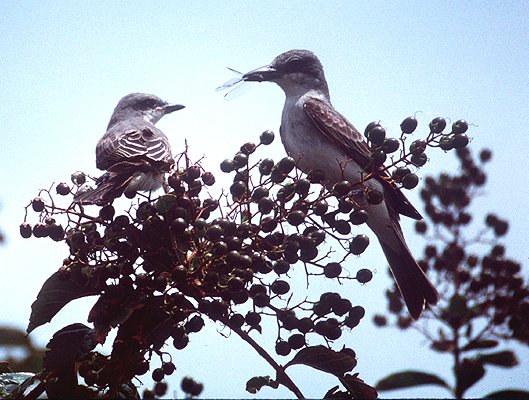 |
|
Photo: G. Beaton
|
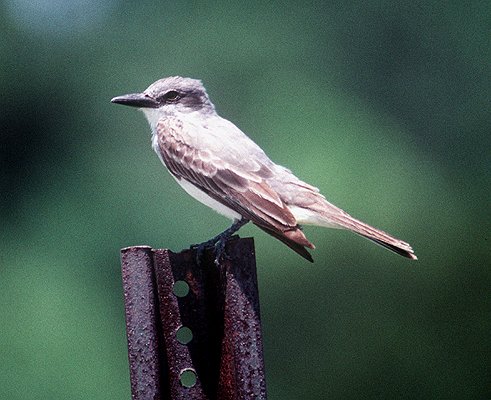 |
|
|
Photo: G. Beaton
|
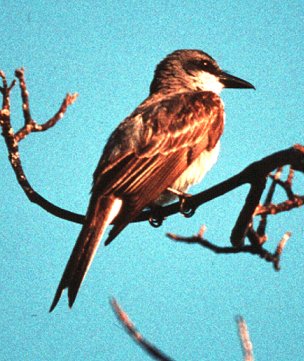 |
|
|
Photo: M. Oberle
|
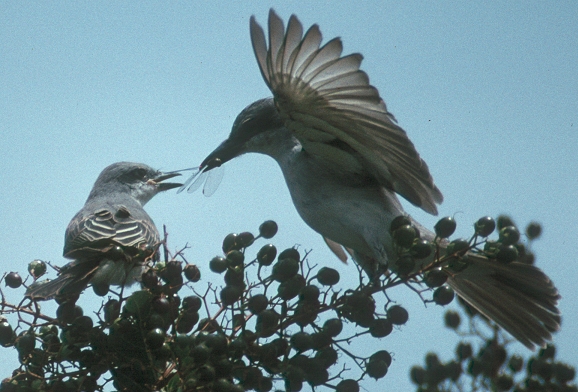 |
|
Photo: G. Beaton
|
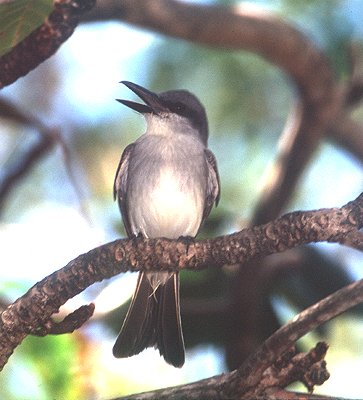 |
|
|
Tyrannus dominicensis vorax
(St. Lucia) -
Photo: G. Beaton |
|
References Arendt, W.J. 1992. Status of North American migrant landbirds in the Caribbean region: a summary. Pp. 143-171 in Ecology and conservation of neotropical migrant landbirds (J.M. Hagan III and D.W. Johnston, eds.) Smithsonian Instit. Press, Washington, D.C. Baltz, M. E. and D. E. Burhans. 1998. Rejection of artificial parasite eggs by Gray Kingbirds in the Bahamas. Condor 100(3): 566-568. Bent, A.C. 1942. Life histories of North American flycatchers, larks, swallows, and their allies. Smithsonian Instit. U.S. National Museum Bull. 179. (Reprinted by Dover Press, NY, 1963). Collazo, J.A. and Bonilla Martínez, G. I. 1988. Comparación de la riqueza de aves entre plantaciones de pino hondureño (Pinus caribaea) y áreas de bosque nativo en el Bosque Estatal de Carite, Cayey, Puerto Rico. Carib. J. Sci. 24:1-10. Ehrlich, P.R., D.S. Dobkin, and D. Wheye. 1988. The birder’s handbook: a field guide to the natural history of North American birds. Simon and Schuster/ Fireside, NY. Cruz, A. 1980. Avian feeding assemblages in Puerto Rico. Carib. J. Sci. 15:21-27. Haberman, K., D.I. MacKenzie, and J.D. Rising. 1991. Geographic variation in the Gray Kingbird. J Field Ornithol., 62(1):117-131. Lefebvre, L., S. M. Reader, and S. J Webster. 2001. Novel food use by Grey Kingbirds and Red-necked Pigeons in Barbados. Bull BOC 121:247-249. Raffaele, H.A. 1989. A guide to the birds of Puerto Rico and the Virgin Islands. Princeton. Raffaele, H.A. 1989. Una guía a las aves de Puerto Rico y las Islas Vírgenes. Publishing Resources, Inc., Santurce, PR. Raffaele, H.A., J.W. Wiley, O.H. Garrido, A.R. Keith, and J.I. Raffaele. 1998. Guide to the birds of the West Indies. Princeton. Seutin, G. and V. Apanius. Gray Flycatcher predation on a hummingbird. Wilson Bull. 107(3):565-567. Smith, G. A., and J. A. Jackson. 2002. Gray Kingbird (Tyrannus dominicensis). In The Birds of North America, No. 668 (A. Poole and F. Gill, eds.). The Birds of North America, Inc., Philadelphia, PA. Next related species in taxonomic order Previous related species in taxonomic order |